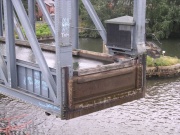Barton Swing Aqueduct







The Barton Swing Aqueduct is a moveable navigable aqueduct in Barton upon Irwell in Greater Manchester.
The structure is located adjacent to, and upstream of, the Barton Road Swing Bridge. The two bridges are controlled from a brick control tower on an island in the centre of the Manchester Ship Canal. The island supports the pivots for the rotating structures. When in the open positions, the aqueduct and road bridge line up along the length of the island, allowing ships to traverse along each side of the ship canal.
The aqueduct carries the Bridgewater Canal across the Manchester Ship Canal, the swinging action allowing large vessels using the Manchester Ship Canal to pass, or narrowboats to cross over the top.
The aqueduct, which is the first and only swing aqueduct in the world, is a Grade II* listed building and is considered a major feat of Victorian civil engineering.
Designed by Edward Leader Williams and built by Andrew Handyside and Co of Derby, the swing bridge opened in 1894 and remains in use, although it is now rarely required to open it for Ship Canal traffic.
The Barton Swing Aqueduct was a direct replacement for the earlier Barton Aqueduct, a stone structure crossing the River Irwell. The original stone aqueduct was designed by James Brindley and dated from 1761; it was described as "one of the seven wonders of the canal age".
The construction of the Manchester Ship Canal in the 1890s necessitated the replacement of this structure, as the height of ships using the new ship canal would make them too large to pass under the original aqueduct. An alternative scheme involving the use of a double lock flight was not used, because of the need to conserve water in the Bridgewater canal above.
Sir Edward Leader Williams, engineer to the Manchester Ship Canal Company, was credited with the design of the aqueduct. However W. H. Thorpe of Derby wrote to Engineering to state that he had designed all the ironwork, including calculations and detailing.[1]. It was built by Andrew Handyside of Derby. It became operational with the first barge crossing it on 21 August 1893. The aqueduct was commercially opened on 1 January 1894.
When closed, it allows canal traffic to pass along the Bridgewater Canal. When large vessels need to pass along the Ship Canal, the 1,450-tonne and 330-foot long iron trough is rotated 90 degrees on a pivot mounted on a small, purpose-built island in the Ship Canal. A gate at each end of the trough retains around 800 tonnes of water; further gates on each bank retain water in their adjacent stretches of canal. The aqueduct once had a suspended towpath along its length; however, this has been removed in recent years on grounds of safety.
Both bridges revolve on 64 tapered rollers. In addition they had a central pivot on a hydraulic jack, known as the centre press, which relieved the pressure on the rollers during turning. The aqueduct's ram was 4 ft 9" diameter and exerted an upward force of 800 tons. In 1927 the cast iron rollers and races were replaced in steel by William Arrol and Co as a result of wear, and the use of the centre press was discontinued. Similar work was done on the road bridge in 1938. The original hydraulic pumping and turning machinery was supplied by W. G. Armstrong and Co. In 1939 the aqueduct's hysdraulic motors were replaced by a pair of radial 3-cylinder hydraulic motors by the Hydraulic Engineering Co of Chester. In 1940 the hydraulic pumps were replaced by electrically-drive multi-stage centrifugal pumps by Mather and Platt. The old steam power station was demolished after the war.[2]
See Also
Sources of Information
- ↑ Engineering 1894/02/02
- ↑ Barton's Bridges by Glen Atkinson, published in 2002 by Neil Richardson
- [1] Wikipedia

